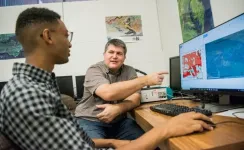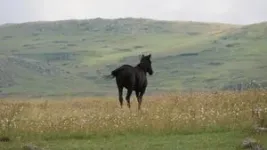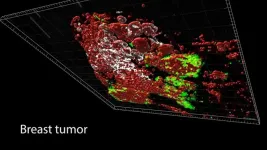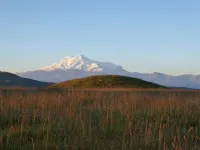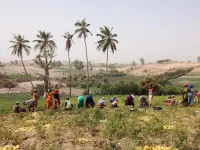(Press-News.org) A new study in Nature finds that up to 215 million hectares of land (an area larger than Mexico) in humid tropical regions around the world has the potential to naturally regrow. That much forest could store 23.4 gigatons of carbon over 30 years and also have a significant impact on concerns like biodiversity loss and water quality. The study showed that more than half of the area with strong potential for regrowth was in five countries: Brazil, Mexico, Indonesia, China, and Colombia.
“Tree planting in degraded landscapes can be costly. By leveraging natural regeneration techniques, nations can meet their restoration goals cost effectively,” says the study’s co-lead author, Brooke Williams, a researcher at the Queensland University of Technology, Australia, and the Institute for Capacity Exchange in Environmental Decisions. “Our model can guide where these savings can best be taken advantage of,” she says.
A culmination of decades of work
Matthew Fagan, associate professor of geography and environmental systems at University of Maryland, Baltimore County (UMBC) and second author on the new study, developed a data set the authors relied on.
In that work, “We used satellite images to identify millions of small areas where tree cover increased over time. We then excluded the areas planted by humans with machine learning, focusing on natural regrowth,” Fagan says. The study tracked regrowth between 2000 and 2012, and then checked if the regrowth was maintained through 2015. “Those natural patches were the input data for this novel study,” he says, “the first to predict where future forest regrowth will occur, given observed past regrowth.”
The study, co-led by Hawthorne Beyer, head of geospatial science at Mombak, a Brazilian startup which aims to generate high-quality carbon credits through reforestation of the Amazon, and director of science at Institute for Capacity Exchange in Environmental Decisions, also pulled in global data sets describing factors like soil quality, slope, road and population density, local wealth, distance from urban centers and from healthy forest, and more. “Any time you build one of these global studies, you’re standing on the backs of so many other scientists,” Fagan says. “Each one of these studies represents years of work.”
The study found that the factors most strongly associated with high regrowth potential were a patch’s proximity to existing forest, the density of nearby forest, and the content of carbon in the soil. Those factors in particular “seem to do a really good job explaining the patterns of regrowth we see across the world,” Fagan says. Being close to existing forest, for example, is key to supplying a variety of seeds to the area to support diverse regrowth, Fagan explains.
Keeping it local—by supplying a global map
The end product of the study is a digital map of the global tropics, where each pixel—representing 30 x 30 square meters of land—indicates the estimated potential for regrowth. That map, made possible by an extensive international collaboration of researchers, is a boon to environmentalists worldwide hoping to advocate locally for their efforts.
“Our goal and our hope is that this is used democratically by local people, organizations, and localities from the county level all the way up to the national level, to advocate for where restoration should happen,” Fagan says. “The people who live there should be in charge of what happens there—where and how to restore really depends on local conditions.”
Fagan points out that some of the potential regrowth areas the study identified are unlikely to be restored for a variety of reasons, such as being in active use for ranching or crops or located on prime real estate near roads and urban centers. However, a meaningful portion of the 215 million hectares is abandoned and degraded cattle pastures or previously logged forests, where encouraging natural regeneration would have minimal cost to local economies and a long list of benefits.
“If you restored that to rainforest, the benefit to water quality, water provision, local biodiversity, and to soil quality would be immense,” Fagan says. “It would also be an immense benefit for pulling carbon out of the atmosphere, so really it’s just a question of, ‘Where can we do this most efficiently?’ That’s what this paper is all about.”
END
Study shows natural regrowth of tropical forests has immense potential to address environmental concerns
A potential regrowth area larger than Mexico could store 23.4 gigatons of carbon
2024-10-30
ELSE PRESS RELEASES FROM THIS DATE:
After a heart attack, the heart signals to the brain to increase sleep to promote healing
2024-10-30
A heart attack can trigger a desire to get more sleep, allowing the heart to heal and reduce inflammation—and this happens because the heart sends special signals to the brain, according to a new Mount Sinai study. This research is the first to demonstrate how the heart and brain communicate with each other through the immune system to promote sleep and recovery after a major cardiovascular event.
The novel findings, published October 30 in Nature, emphasize the importance of increased sleep after a heart attack, and suggest that sufficient sleep should be a focus of post-heart-attack clinical management ...
Complexity of tumors revealed in 3D
2024-10-30
A new analysis led by researchers at Washington University School of Medicine in St. Louis has revealed detailed 3D maps of the internal structures of multiple tumor types. These cancer atlases reveal how different tumor cells — and the cells of a tumor’s surrounding environment — are organized, in 3D, and how that organization changes when a tumor spreads to other organs.
The detailed findings offer scientists valuable blueprints of tumors that could lead to new approaches to therapy and spark a new era in the field of cancer biology, according to the researchers.
The study is part of a group of 12 papers published Oct. 30 in the Nature suite of journals by members ...
Into the great wide open: How steppe pastoralist groups formed and transformed over time
2024-10-30
The wider Caucasus region, between the Black and the Caspian Seas, connects Europe, the Near East and Asia. It displays a huge geographic, ecological, economic, cultural, and linguistic range today, from the steppe zone in the north, the Caucasus mountains in the center, to the highlands of today’s Armenia, Georgia, Azerbaijan and Iran in the south. This diversity was no different in the past, where the archaeological record attests to many different influences from many surrounding regions.
“It is precisely this interface of different eco-geographic features ...
Determining precise timing of cellular growth to understand the origins of cancer
2024-10-30
Cancers are diseases of abnormal cellular growth, and although many are treatable or even curable, their origins are not necessarily clear. Understanding the precise timing of cellular events—as cells transition from normal to cancerous conditions—is key to uncovering new treatments or diagnostic opportunities.
Scientists from Vanderbilt University, led by Mirazul Islam, a graduate student mentored by Professor of Cell and Developmental Biology Ken Lau and Professor of Medicine Robert Coffey, have laid the groundwork for understanding and predicting the natural transition between precancers and cancer. They showed that colorectal cancer is likely to ...
Healthy brains suppress inappropriate immune responses
2024-10-30
The brain constantly engages in dialogue with the body’s immune system. Such communication appears aimed at ensuring a delicate balance between defending against injury and infection and guarding healthy tissue.
Now, scientists at Washington University School of Medicine in St. Louis have revealed how the two strike a healthy balance. The study, in mice, found that fragments of immune-stimulating proteins – dubbed guardian peptides – are produced by the brain and spinal cord of the central nervous system to maintain ...
Large meltwater accumulation revealed inside Greenland Ice Sheet
2024-10-30
A new study published in Nature unveils a surprising discovery: a substantial amount of meltwater is temporarily stored within the Greenland Ice Sheet during summer months. For the first time, an international group of researchers was able to quantify meltwater with positioning data. The finding challenges current models of how ice sheets contribute to global sea level rise.
The Greenland Ice Sheet is currently the largest single contributor to global sea-level rise, with the potential to raise the mean sea level by up to seven meters if it fully melts. While ...
Ancient DNA brings to life history of the iconic aurochs, whose tale is intertwined with climate change and human culture
2024-10-30
Geneticists from Trinity College Dublin, together with an international team of researchers, have deciphered the prehistory of aurochs – the animals that were the focus of some of the most iconic early human art – by analysing 38 genomes harvested from bones dating across 50 millennia and stretching from Siberia to Britain.
The aurochs roamed in Europe, Asia and Africa for hundreds of thousands of years. Adorned as paintings on many a cave wall, their domestication to create cattle gave us a harnessed source of muscle, meat and milk. Such ...
Reversing environmental decline: Lessons from African communities
2024-10-30
In rural Africa, where livelihoods are often tied directly to the land, environmental degradation poses a critical threat to both ecosystems and people’s well-being. New research reveals ways to tackle the dual challenges of land degradation and poverty.
In rural Africa, where livelihoods are often tied directly to the land, environmental degradation poses a critical threat to both ecosystems and people’s well-being. A new study co-authored by researchers at Stanford University and the French Agricultural Research Centre for International Development (CIRAD) analyzes how ...
'Black box' of stem cell transplants opened in world-first blood study
2024-10-30
For the first time, scientists have tracked what happens to stem cells decades after a transplant, lifting the lid on the procedure that has been a medical mystery for over 50 years.
Insights could pave the way for new strategies in donor selection and transplant success, potentially leading to safer, more effective transplants.
Researchers from the Wellcome Sanger Institute and their collaborators at the University of Zurich were able to map the behaviour of stem cells in recipients’ bodies up to three decades post-transplant, ...
New pathway for sensing cold temperatures identified in rice
2024-10-30
A gene called COLD6 contributes to cold tolerance in rice, potentially offering a pathway to use molecular design to breed a rice variety with higher resistance to cold stress. This work appears October 30 in the Cell Press journal Molecular Cell.
“Cold damage is a major challenge in rice production, and identifying key gene modules in signalling pathways is a crucial step in addressing this issue,” says senior study author Kang Chong of the Chinese Academy of Sciences. “Our research focused on uncovering the molecular mechanism behind crops’ response to cold stress. We hope to ...
LAST 30 PRESS RELEASES:
Air pollution exposure and birth weight
Obstructive sleep apnea risk and mental health conditions among older adults
How talking slows eye movements behind the wheel
The Ceramic Society of Japan’s Oxoate Ceramics Research Association launches new international book project
Heart-brain connection: international study reveals the role of the vagus nerve in keeping the heart young
Researchers identify Rb1 as a predictive biomarker for a new therapeutic strategy in some breast cancers
Survey reveals ethical gaps slowing AI adoption in pediatric surgery
Stimulant ADHD medications work differently than thought
AI overestimates how smart people are, according to HSE economists
HSE researchers create genome-wide map of quadruplexes
Scientists boost cell "powerhouses" to burn more calories
Automatic label checking: The missing step in making reliable medical AI
Low daily alcohol intake linked to 50% heightened mouth cancer risk in India
American Meteorological Society announces Rick Spinrad as 2026 President-Elect
Biomass-based carbon capture spotlighted in newly released global climate webinar recording
Illuminating invisible nano pollutants: advanced bioimaging tracks the full journey of emerging nanoscale contaminants in living systems
How does age affect recovery from spinal cord injury?
Novel AI tool offers prognosis for patients with head and neck cancer
Fathers’ microplastic exposure tied to their children’s metabolic problems
Research validates laboratory model for studying high-grade serous ovarian cancer
SIR 2026 delivers transformative breakthroughs in minimally invasive medicine to improve patient care
Stem Cell Reports most downloaded papers of 2025 highlight the breadth and impact of stem cell research
Oxford-led study estimates NHS spends around 3% of its primary and secondary care budget on the health impacts of heat and cold in England
A researcher’s long quest leads to a smart composite breakthrough
Urban wild bees act as “microbial sensors” of city health.
New study finds where you live affects recovery after a hip fracture
Forecasting the impact of fully automated vehicle adoption on US road traffic injuries
Alcohol-related hospitalizations from 2016 to 2022
Semaglutide and hospitalizations in patients with obesity and established cardiovascular disease
Researchers ‘listen in’ to embryo-mother interactions during implantation using a culture system replicating the womb lining
[Press-News.org] Study shows natural regrowth of tropical forests has immense potential to address environmental concernsA potential regrowth area larger than Mexico could store 23.4 gigatons of carbon
